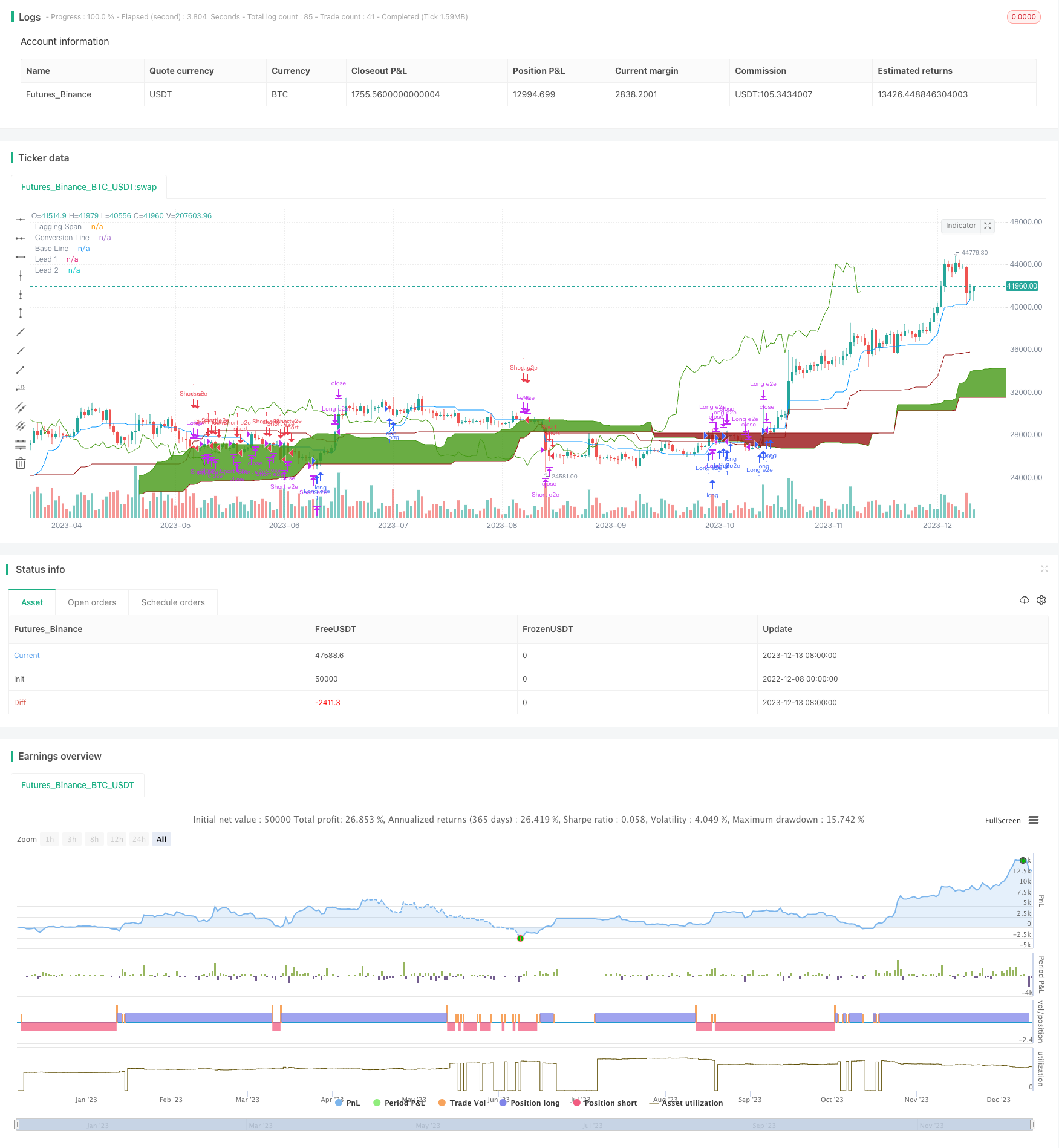
概述
本策略基于一支蜡烛图指标——Ichimoku Kinko Hyo进行交易信号生成。Ichimoku Kinko Hyo直译为“一目均衡表”,它融合了移动平均线和波段指标的优点,可以同时识别趋势方向和支持阻力位,被视为一种综合指标。
本策略运用Ichimoku Kinko Hyo的成分线来判断趋势方向和强弱。当价格突破云图上下轨时产生交易信号。同时,策略还利用“边沿对边沿”入场机会,这是Ichimoku独特的交易机会。
策略原理
本策略使用了Ichimoku Kinko Hyo的五条成分线:
- Tenkan线(转折线):最高价和最低价的9日平均
- Kijun线(基准线):最高价和最低价的26日平均
- Senkou Span A(先行一):Tenkan线和Kijun线的平均
- Senkou Span B(先行二):最高价和最低价的52日平均
- Chikou线(迟行线):收盘价的26日迟移平均
另外绘制Ichimoku的云图,由Senkou Span A和Senkou Span B组成,大体代表目前的趋势区间。
本策略的交易信号来源于以下情形:
- 价格从下方突破云图上轨:做多信号
- 价格从上方突破云图下轨:做空信号
- 价格从云图下方进入云图: 做多“边沿对边沿”入场机会
- 价格从云图上方进入云图: 做空“边沿对边沿”入场机会
此外,策略还判断Tenkan线和Kijun线的金叉死叉作为止盈和止损的时机。
策略优势
本策略最大的优势在于利用Ichimoku Kinko Hyo指标判断趋势方向和支持阻力的能力强。
- 用云图判断主要趋势方向,避免逆势操作。
- 用成分线识别支持阻力位,找准突破的交易机会。
- 增加“边沿对边沿”入场机会,扩大获利空间。
另外,本策略加入了金叉止损和死叉止盈模块,可以锁定部分利润,控制风险。
风险及解决
本策略主要的风险在于Ichimoku成分线算法导致的潜在跳空。这会造成虚假突破的风险。
解决方法是适当调整算法参数,缩小成分线间的距离,或者加入过滤器条件,避免进入震荡区间。
策略优化
本策略有几个可以优化的方向:
优化Ichimoku成分线的参数,调整均线周期,适应更多品种和周期。
增加成交量的确认,避免跳空造成的虚假信号。
结合其他指标过滤,例如MACD、RSI等,识别趋势和超买超卖区域。
优化止损止盈逻辑,例如移动止损、缩量等方法。
总结
总而言之,本策略利用Ichimoku Kinko Hyo的云图和成分线判断趋势方向和交易机会。策略优势在于趋势判断清晰,入场时机精准。通过优化参数和增加过滤条件,可以进一步降低虚假信号比率,从而得到更好的策略表现。
/*backtest
start: 2022-12-08 00:00:00
end: 2023-12-14 00:00:00
period: 1d
basePeriod: 1h
exchanges: [{"eid":"Futures_Binance","currency":"BTC_USDT"}]
*/
//@version=5
strategy("Ichimoku Cloud", shorttitle="Ichimoku", overlay=true)
previous_close = close[1]
conversionPeriods = input.int(20, minval=1, title="Conversion Line Periods"),
basePeriods = input.int(60, minval=1, title="Base Line Periods")
laggingSpan2Periods = input.int(120, minval=1, title="Lagging Span 2 Periods"),
displacement = input.int(30, minval=1, title="Displacement")
long_entry = input.bool(true, title="Long Entry")
short_entry = input.bool(true, title="Short Entry")
e2e_entry = input.bool(true, title="E2E Entry")
donchian(len) => math.avg(ta.lowest(len), ta.highest(len))
tenkan = donchian(conversionPeriods)
kijun = donchian(basePeriods)
spanA = math.avg(tenkan, kijun)
spanB = donchian(laggingSpan2Periods)
plot(tenkan, color=#0496ff, title="Conversion Line")
plot(kijun, color=#991515, title="Base Line")
plot(close, offset = -displacement, color=#459915, title="Lagging Span")
p1 = plot(spanA, offset = displacement, color=#459915, title="Lead 1")
p2 = plot(spanB, offset = displacement, color=#991515, title="Lead 2")
fill(p1, p2, color = spanA > spanB ? #459915 : #991515)
ss_high = math.max(spanA[displacement - 1], spanB[displacement - 1])
ss_low = math.min(spanA[displacement - 1], spanB[displacement - 1])
// Entry/Exit Signals
tk_cross_bull = tenkan > kijun
tk_cross_bear = tenkan < kijun
kumo_twist_bull = ta.mom(close, displacement) > 0
kumo_twist_bear = ta.mom(close, displacement) < 0
price_above_kumo = close > ss_high
price_below_kumo = close < ss_low
price_enters_kumo_top = previous_close > ss_high[1] and close < ss_high
price_enters_kumo_bottom = previous_close < ss_low[1] and close > ss_low
bullish = tk_cross_bull and kumo_twist_bull and price_above_kumo
bearish = tk_cross_bear and kumo_twist_bear and price_below_kumo
bullishe2e = price_enters_kumo_bottom // and tk_cross_bull
bearishe2e = price_enters_kumo_top // and tk_cross_bear
price_touches_kumo_top = ta.cross(close, ss_high)
price_touches_kumo_bottom = ta.cross(close, ss_low)
strategy.entry("Long", strategy.long, when=bullish and long_entry)
strategy.close("Long", when=tk_cross_bear)
strategy.close("Long", when=price_enters_kumo_top)
strategy.entry("Long e2e", strategy.long, when=bullishe2e and e2e_entry)
strategy.close("Long e2e", when=price_touches_kumo_top)
strategy.close("Long e2e", when=price_below_kumo, qty_percent = 100)
// strategy.close("Long e2e", when=ta.cross(close, kijun), qty_percent = 50)
strategy.entry("Short", strategy.short, when=bearish and short_entry)
strategy.close("Short", when=tk_cross_bull)
strategy.close("Short", when=price_enters_kumo_bottom)
strategy.entry("Short e2e", strategy.short, when=bearishe2e and e2e_entry)
strategy.close("Short e2e", when=price_touches_kumo_bottom)
strategy.close("Short e2e", when=price_above_kumo, qty_percent = 100)
// strategy.close("Long e2e", when=ta.cross(close, kijun), qty_percent = 50)